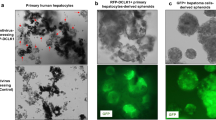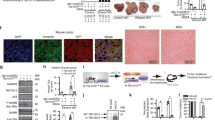Abstract
p53 plays a major role in the prevention of tumor development. It responds to a range of potentially oncogenic stresses by activating protective mechanisms, most notably cell-cycle arrest and apoptosis. The p53 gene is also induced during normal liver regeneration, and it has been hypothesized that p53 serve as a proliferative ‘brake’ to control excessive proliferation. However, it has lately been shown that p53 inhibition reduces hepatocyte growth factor-induced DNA synthesis of primary hepatocytes. Here we show that epidermal growth factor (EGF) activated p53 in a phosphatidylinositol-3 kinase-dependent way, and thus induced the cyclin-dependent kinase inhibitor p21Cip1 in primary rat hepatocytes. p53 inactivation with a dominant-negative mutant (p53V143A) attenuated EGF-induced DNA synthesis and was associated with reduced CDK2 phosphorylation and retinoblastoma protein hyperphosphorylation. When p21Cip1 was ectopically expressed in p53-inactivated cells, these effects were neutralized. In conclusion, our results demonstrate that in normal hepatocytes, EGF-induced expression of p53 is involved in regulating CDK2- and CDK4 activity, through p21Cip1 expression.
This is a preview of subscription content, access via your institution
Access options
Subscribe to this journal
Receive 50 print issues and online access
$259.00 per year
only $5.18 per issue
Buy this article
- Purchase on Springer Link
- Instant access to full article PDF
Prices may be subject to local taxes which are calculated during checkout






Similar content being viewed by others
References
Alt JR, Gladden AB, Diehl JA . (2002). p21(Cip1) Promotes cyclin D1 nuclear accumulation via direct inhibition of nuclear export. J Biol Chem 277: 8517–8523.
Alves da Costa C, Paitel E, Mattson MP, Amson R, Telerman A, Ancolio K et al. (2002). Wild-type and mutated presenilins 2 trigger p53-dependent apoptosis and down-regulate presenilin 1 expression in HEK293 human cells and in murine neurons. Proc Natl Acad Sci USA 99: 4043–4048.
Arora V, Iversen PL . (2000). Antisense oligonucleotides targeted to the p53 gene modulate liver regeneration in vivo. Drug Metab Dispos 28: 131–138.
Bar J, Lukaschuk N, Zalcenstein A, Wilder S, Seger R, Oren M . (2005). The PI3K inhibitor LY294002 prevents p53 induction by DNA damage and attenuates chemotherapy-induced apoptosis. Cell Death Differ 12: 1578–1587.
Barak Y, Juven T, Haffner R, Oren M . (1993). mdm2 expression is induced by wild type p53 activity. EMBO J 12: 461–468.
Cheng M, Olivier P, Diehl JA, Fero M, Roussel MF, Roberts JM et al. (1999). The p21(Cip1) and p27(Kip1) CDK ‘inhibitors’ are essential activators of cyclin D-dependent kinases in murine fibroblasts. EMBO J 18: 1571–1583.
Coutant A, Rescan C, Gilot D, Loyer P, Guguen-Guillouzo C, Baffet G . (2002). PI3K-FRAP/mTOR pathway is critical for hepatocyte proliferation whereas MEK/ERK supports both proliferation and survival. Hepatology 36: 1079–1088.
Diehl JA, Sherr CJ . (1997). A dominant-negative cyclin D1 mutant prevents nuclear import of cyclin-dependent kinase 4 (CDK4) and its phosphorylation by CDK-activating kinase. Mol Cell Biol 17: 7362–7374.
Diller L, Kassel J, Nelson CE, Gryka MA, Litwak G, Gebhardt M et al. (1990). p53 functions as a cell cycle control protein in osteosarcomas. Mol Cell Biol 10: 5772–5781.
el-Deiry WS, Tokino T, Velculescu VE, Levy DB, Parsons R, Trent JM et al. (1993). WAF1, a potential mediator of p53 tumor suppression. Cell 75: 817–825.
Fausto N, Mead JE, Braun L, Thompson NL, Panzica M, Goyette M et al. (1986). Proto-oncogene expression and growth factors during liver regeneration. Symp Fundam Cancer Res 39: 69–86.
Friedlander P, Legros Y, Soussi T, Prives C . (1996). Regulation of mutant p53 temperature-sensitive DNA binding. J Biol Chem 271: 25468–25478.
Fujiwara Y, Kawada K, Takano D, Tanimura S, Ozaki K, Kohno M . (2006). Inhibition of the PI3 kinase/Akt pathway enhances doxorubicin-induced apoptotic cell death in tumor cells in a p53-dependent manner. Biochem Biophys Res Commun 340: 560–566.
Gallant P, Fry AM, Nigg EA . (1995). Protein kinases in the control of mitosis: focus on nucleocytoplasmic trafficking. J Cell Sci (Suppl) 19: 21–28.
Geisen C, Moroy T . (2002). The oncogenic activity of cyclin E is not confined to Cdk2 activation alone but relies on several other, distinct functions of the protein. J Biol Chem 277: 39909–39918.
Ghosh AK, Bhattacharyya S, Varga J . (2004). The tumor suppressor p53 abrogates Smad-dependent collagen gene induction in mesenchymal cells. J Biol Chem 279: 47455–47463.
Harper JW, Adami GR, Wei N, Keyomarsi K, Elledge SJ . (1993). The p21 Cdk-interacting protein Cip1 is a potent inhibitor of G1 cyclin-dependent kinases. Cell 75: 805–816.
Hirota YY, Horiuchi TT, Akahane KK . (1996). p53 antisense oligonucleotide inhibits growth of human colon tumor and normal cell lines. Jpn J Cancer Res 87: 735–742.
Hofseth LJ, Hussain SP, Harris CC . (2004). p53: 25 years after its discovery. Trends Pharmacol Sci 25: 177–181.
Ilyin GP, Glaise D, Gilot D, Baffet G, Guguen-Guillouzo C . (2003). Regulation and role of p21 and p27 cyclin-dependent kinase inhibitors during hepatocyte differentiation and growth. Am J Physiol Gastrointest Liver Physiol 285: G115–G127.
Inoue Y, Tomiya T, Yanase M, Arai M, Ikeda H, Tejima K et al. (2002). p53 May positively regulate hepatocyte proliferation in rats. Hepatology 36: 336–344.
Kastan MB, Zhan Q, el-Deiry WS, Carrier F, Jacks T, Walsh WV et al. (1992). A mammalian cell cycle checkpoint pathway utilizing p53 and GADD45 is defective in ataxia-telangiectasia. Cell 71: 587–597.
Kelly BL, Wolfe KG, Roberts JM . (1998). Identification of a substrate-targeting domain in cyclin E necessary for phosphorylation of the retinoblastoma protein. Proc Natl Acad Sci USA 95: 2535–2540.
Komarov PG, Komarova EA, Kondratov RV, Christov-Tselkov K, Coon JS, Chernov MV et al. (1999). A chemical inhibitor of p53 that protects mice from the side effects of cancer therapy. Science 285: 1733–1737.
LaBaer J, Garrett MD, Stevenson LF, Slingerland JM, Sandhu C, Chou HS et al. (1997). New functional activities for the p21 family of CDK inhibitors. Genes Dev 11: 847–862.
Latonen L, Kurki S, Pitkanen K, Laiho M . (2003). p53 and MDM2 are regulated by PI-3-kinases on multiple levels under stress induced by UV radiation and proteasome dysfunction. Cell Signal 15: 95–102.
Lin D, Shields MT, Ullrich SJ, Appella E, Mercer WE . (1992). Growth arrest induced by wild-type p53 protein blocks cells prior to or near the restriction point in late G1 phase. Proc Natl Acad Sci USA 89: 9210–9214.
Loyer P, Cariou S, Glaise D, Bilodeau M, Baffet G, Guguen-Guillouzo C . (1996). Growth factor dependence of progression through G1 and S phases of adult rat hepatocytes in vitro. Evidence of a mitogen restriction point in mid-late G1 . J Biol Chem 271: 11484–11492.
Ludes-Meyers JH, Subler MA, Shivakumar CV, Munoz RM, Jiang P, Bigger JE et al. (1996). Transcriptional activation of the human epidermal growth factor receptor promoter by human p53. Mol Cell Biol 16: 6009–6019.
Lundberg AS, Weinberg RA . (1998). Functional inactivation of the retinoblastoma protein requires sequential modification by at least two distinct cyclin–cdk complexes. Mol Cell Biol 18: 753–761.
Matsuoka M, Kato JY, Fisher RP, Morgan DO, Sherr CJ . (1994). Activation of cyclin-dependent kinase 4 (cdk4) by mouse MO15-associated kinase. Mol Cell Biol 14: 7265–7275.
Maya R, Balass M, Kim ST, Shkedy D, Leal JF, Shifman O et al. (2001). ATM-dependent phosphorylation of Mdm2 on serine 395: role in p53 activation by DNA damage. Genes Dev 15: 1067–1077.
Mayo LD, Turchi JJ, Berberich SJ . (1997). Mdm-2 phosphorylation by DNA-dependent protein kinase prevents interaction with p53. Cancer Res 57: 5013–5016.
Metcalfe AM, Dixon RM, Radda GK . (1997). Wild-type but not mutant p53 activates the hepatocyte growth factor/scatter factor promoter. Nucleic Acids Res 25: 983–986.
Michael D, Oren M . (2003). The p53-Mdm2 module and the ubiquitin system. Semin Cancer Biol 13: 49–58.
Monti P, Campomenosi P, Ciribilli Y, Iannone R, Inga A, Abbondandolo A et al. (2002). Tumour p53 mutations exhibit promoter selective dominance over wild type p53. Oncogene 21: 1641–1648.
Naderi S, Wang JY, Chen TT, Gutzkow KB, Blomhoff HK . (2005). cAMP-mediated inhibition of DNA replication and S phase progression: involvement of Rb, p21Cip1, and PCNA. Mol Biol Cell 16: 1527–1542.
Nicholson KM, Anderson NG . (2002). The protein kinase B/Akt signalling pathway in human malignancy. Cell Signal 14: 381–395.
Rosseland CM, Wierod L, Oksvold MP, Werner H, Ostvold AC, Thoresen GH et al. (2005). Cytoplasmic retention of peroxide-activated ERK provides survival in primary cultures of rat hepatocytes. Hepatology 42: 200–207.
Saito A, Hayashi T, Okuno S, Nishi T, Chan PH . (2005). Modulation of p53 degradation via MDM2-mediated ubiquitylation and the ubiquitin–proteasome system during reperfusion after stroke: role of oxidative stress. J Cereb Blood Flow Metab 25: 267–280.
Sheikh MS, Carrier F, Johnson AC, Ogdon SE, Fornace Jr AJ . (1997). Identification of an additional p53-responsive site in the human epidermal growth factor receptor gene promotor. Oncogene 15: 1095–1101.
Sherr CJ, Roberts JM . (2004). Living with or without cyclins and cyclin-dependent kinases. Genes Dev 18: 2699–2711.
Shin TH, Paterson AJ, Kudlow JE . (1995). p53 stimulates transcription from the human transforming growth factor alpha promoter: a potential growth-stimulatory role for p53. Mol Cell Biol 15: 4694–4701.
Skarpen E, Lindeman B, Thoresen GH, Guren TK, Oksvold MP, Christoffersen T et al. (2000). Impaired nuclear accumulation and shortened phosphorylation of ERK after growth factor stimulation in cultured hepatocytes from rats exposed to 2-acetylaminofluorene. Mol Carcinog 28: 84–96.
Tang HY, Zhao K, Pizzolato JF, Fonarev M, Langer JC, Manfredi JJ . (1998). Constitutive expression of the cyclin-dependent kinase inhibitor p21 is transcriptionally regulated by the tumor suppressor protein p53. J Biol Chem 273: 29156–29163.
Tassan JP, Schultz SJ, Bartek J, Nigg EA . (1994). Cell cycle analysis of the activity, subcellular localization, and subunit composition of human CAK (CDK-activating kinase). J Cell Biol 127: 467–478.
Thompson NL, Mead JE, Braun L, Goyette M, Shank PR, Fausto N . (1986). Sequential protooncogene expression during rat liver regeneration. Cancer Res 46: 3111–3117.
Vivanco I, Sawyers CL . (2002). The phosphatidylinositol 3-Kinase AKT pathway in human cancer. Nat Rev Cancer 2: 489–501.
Vousden KH, Lu X . (2002). Live or let die: the cell's response to p53. Nat Rev Cancer 2: 594–604.
Weinberg RA . (1995). The retinoblastoma protein and cell cycle control. Cell 81: 323–330.
Wong KB, DeDecker BS, Freund SM, Proctor MR, Bycroft M, Fersht AR . (1999). Hot-spot mutants of p53 core domain evince characteristic local structural changes. Proc Natl Acad Sci USA 96: 8438–8442.
Wu F, Zhang M, Gong W . (2001). Crystallization and preliminary crystallographic studies of an apoptosis-linked calcium-binding protein ALG-2. Acta Crystallogr D Biol Crystallogr 57: 1162–1163.
Zhou BP, Liao Y, Xia W, Zou Y, Spohn B, Hung MC . (2001). HER-2/neu induces p53 ubiquitination via Akt-mediated MDM2 phosphorylation. Nat Cell Biol 3: 973–982.
Acknowledgements
We thank Heidi K Blomhoff for generously providing the p21Cip wild-type plasmid. This work was supported by grant 134720/310 from the Research Council of Norway and from the Norwegian Cancer Society.
Author information
Authors and Affiliations
Corresponding author
Rights and permissions
About this article
Cite this article
Wierød, L., Rosseland, C., Lindeman, B. et al. Activation of the p53–p21Cip1 pathway is required for CDK2 activation and S-phase entry in primary rat hepatocytes. Oncogene 27, 2763–2771 (2008). https://doi.org/10.1038/sj.onc.1210937
Received:
Revised:
Accepted:
Published:
Issue Date:
DOI: https://doi.org/10.1038/sj.onc.1210937
Keywords
This article is cited by
-
p53 positively regulates the proliferation of hepatic progenitor cells promoted by laminin-521
Signal Transduction and Targeted Therapy (2022)
-
Suppressor of cytokine signaling 1-dependent regulation of the expression and oncogenic functions of p21CIP1/WAF1 in the liver
Oncogene (2016)
-
Biomarker identification of rat liver regeneration via adaptive logistic regression
International Journal of Automation and Computing (2016)



